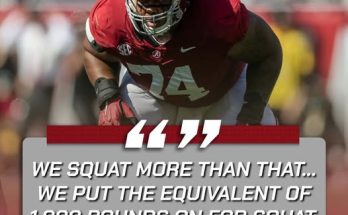The anticipation in the air was almost tangible as players, coaches, and staff rolled into the facility for the highly anticipated joint practice, a day that had been circled on calendars for weeks. Joint practices are a unique blend of competition and collaboration, where two teams bring their full rosters, schemes, and attitudes together to sharpen skills against unfamiliar opposition before the bright lights of the regular season. For the players, it’s a chance to test themselves against talent they don’t see every day, to evaluate their progress, and to show both their own coaching staff and their opponents exactly what they can bring to the table. The phrase “Checking In and Locked In” perfectly encapsulated the mood—each arrival wasn’t just about signing into the venue but mentally entering a space where focus, energy, and determination would define the day.
From the moment the first buses pulled in and players stepped off, there was a mix of business and excitement in their demeanor. Some wore the relaxed smiles of athletes ready for a challenge they’ve been craving, while others kept their heads down, eyes fixed straight ahead, fully immersed in their mental preparation. Equipment managers hurried to get gear in place, trainers coordinated warm-up routines, and coaches compared notes with their counterparts from the other team, setting the stage for a productive day. While fans sometimes see joint practices as just a more controlled form of a preseason game, those on the inside know that these sessions can be more intense, more revealing, and often more meaningful in determining a team’s readiness.
Joint practices are where reputations are built, especially for younger players and those on the roster bubble. For rookies, the stakes feel amplified. Facing players from a different system means they can’t rely solely on familiarity—they must adapt quickly, react instinctively, and execute under pressure. A cornerback who has been going up against his own receivers all camp suddenly faces a different route-running style, a different release off the line, and possibly a higher caliber of competition. The same goes for offensive linemen tasked with blocking defenders who use different techniques than what they’ve been seeing for weeks. These matchups are the proving grounds where adaptability meets preparation.
The energy on the field during these sessions is unlike any other part of camp. Every rep is scrutinized, every drill carries weight, and the pace is relentless. Coaches push their players harder, knowing the opportunity to face an unfamiliar opponent is a valuable simulation of game-day pressure. Players push each other too, with pride and competitive spirit fueling every snap. The trash talk is often more spirited, but it’s balanced with mutual respect. These aren’t opponents in the standings—at least not yet—but they are competitors in the truest sense, each looking to sharpen their edge.
Veterans often relish these moments as much as the younger players, though for different reasons. For seasoned pros, joint practices are a welcome break from the monotony of going against the same faces day after day. They also know these are chances to set the tone for the younger guys—showing how to balance intensity with discipline, how to win a rep without risking injury, and how to keep emotions in check when the adrenaline spikes. Watching a veteran calmly reset after a tough rep or offer a quick pointer to a teammate can be just as valuable as watching them dominate their matchup.
Preparation for joint practice begins long before arrival. In the days leading up to it, position groups study film not only of their upcoming practice opponents but also of themselves, identifying areas where they can improve before putting those adjustments to the test. Quarterbacks review coverage tendencies, linemen examine pass-rush angles, and defensive backs look for subtle cues in receiver footwork. By the time they check in on the day itself, the mental reps have already been taken—they’re simply waiting to bring them to life on the field.
The atmosphere also feeds off the fact that these practices are often open to more media and sometimes even fans. Cameras catch every move, and every standout play is likely to make its way into highlight reels or social media feeds within hours. That added visibility raises the stakes for everyone involved. A spectacular interception or a perfectly placed deep ball can earn a player recognition that resonates beyond the practice field, while repeated mistakes can draw scrutiny just as quickly.
Of course, with so much intensity, tempers can flare. Joint practices have been known to produce dust-ups, as players refuse to back down when challenged physically. While coaches and officials keep a close eye on maintaining control, they also recognize that a certain level of fire is part of the process. The key is channeling that passion into productive competition rather than letting it derail the session. Most players understand the balance—they know the goal is to make each other better, not to win a practice fight.
As drills progress and players rotate through different stations, the coaching staff meticulously evaluates every interaction. They’re not just looking for physical dominance; they’re watching for communication, leadership, and resilience. Does a receiver come back stronger after getting jammed at the line? Does a defensive lineman adjust his technique after losing leverage? Does a linebacker keep his focus after a missed tackle? These details matter in a setting where every rep could influence roster decisions.
Special teams periods in joint practice often get overlooked, but they are a goldmine for evaluation. For fringe players, excelling on special teams can be the difference between making the roster and getting cut. Coaches watch closely for hustle on coverage units, precision on blocking assignments, and crisp execution on kicks and punts. With two teams present, special teams reps take on a new level of realism, replicating the chaotic, fast-paced environment of an actual game.
By the time the final whistle blows, the day’s work leaves everyone physically drained but mentally sharper. The post-practice scene is a blend of fatigue and satisfaction—players exchanging quick words with their counterparts, swapping jerseys, or simply offering a handshake before heading to the locker rooms. Coaches huddle with their teams, pointing out what went well and what needs improvement before the next session.
For the fans and media, the storylines practically write themselves—rookies making jaw-dropping plays, veterans proving they’ve still got it, and heated moments that show just how much pride and competitiveness is woven into the fabric of the sport. For the teams, though, the value lies in the lessons learned. Mistakes in joint practice are opportunities for correction before they become costly in games. Successes are confidence builders that carry into the season.
Checking in for a joint practice might sound simple on the surface, but for those who live it, it’s an all-in commitment. It’s arriving not just in body but in mindset, ready to bring maximum focus and energy to a day that can shape careers and seasons. It’s embracing the challenge of going toe-to-toe with someone who has no stake in your success. It’s walking off the field knowing you pushed yourself, your teammates, and even your opponents to be better. And in that sense, “locked in” isn’t just a phrase—it’s the only way to truly succeed in the grind of professional sports.



